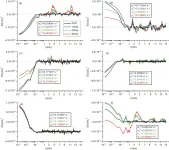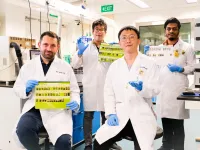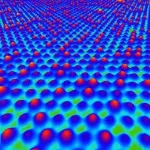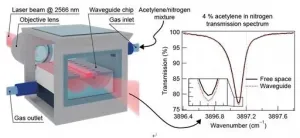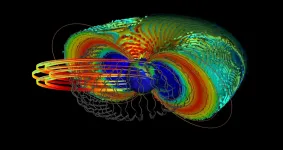(Press-News.org) Loess Plateau possesses a particular loess physiognomy with numerous ravines and slopes, and tableland is a typical landform in it. Together, the ununiform in both topographic undulation and land coverage compose the ununiform, complex underlying surface on Loess Plateau. This provides a special platform for research of turbulence above the complex underlying surface.
As the front-edge problem encountered in the atmospheric boundary layer thesis, the turbulence research for complex underlying surface has drawn extensive attention recently. Local similarity has already proven that under certain condition, theories of turbulence based on the uniform underlying surface can also be applied to which for the ununiform underlying surface. However, as there are still many inapplicable aspects for the complex underlying surface due to its complexity. For eddy-correlation technique, the basic principles of turbulence measurements are ensemble averages of certain space, time, and status, but it is impossible to set up massive equipment within a limited space and obtain all-state for turbulence eddy for a required period time while meeting the ensemble average. Therefore, this experiment bases on such assumption that the fluid field is steady and space are horizontally uniform by replacing the ensemble average with the average of a long-time measurement at one site. So it is necessary to regard the examination of ergodicity for the eddy-correlation technique as the precondition for the experimental research of turbulence in complex terrain of Loess Plateau tableland in its early stage.
Originated in statistic mechanics, the ergodic hypothesis, a principle of examination in microcosmic problem from macro-perspective, has been widely applied recently. Ergodicity theorem has given necessary and sufficient conditions for the stationary stochastic process to satisfy ergodicity. A few researches have revealled the ergodicity of turbulence from Navier-Stokes formula and qualitative researches. We have studied the ergodicity of turbulence measurements above uniform underlying surface. However, it is not researched how atmospheric stratification stability influences on the satisfaction of the ergodic hypothesis. Moreover, low-frequency processes are non-negligible in the estimation of turbulence flux. Under the existing observation conditions, what range of low-frequency processes can satisfy the ergodichy pothesis? These problems are imperative in the early stage of experimental research in turbulence and will be the basis of further researches.
Based on the analysis above, the possible main issues that influence accuracies in measurements of turbulences are the ergodicity of incomplete turbulences such as the unavoidable flows around bodies, especially for those on the Loess Plateau. So, the effects of Monin-Obukhov (M-O) stability on the ergodicity of different scale turbulence in surface layer are studied by applying turbulence data in the tableland of Loess Plateau in this paper. The main goal is to establish a proper scale for turbulence measurements and to improve the estimation accuracy on turbulence flux.
The comprehensive comparison of ergodicity for different-scale horizontal wind velocity, vertical wind velocity, and temperature turbulence under various stratification stability conditions fails to conclude a law of variation for turbulence measurement ergodicity with respect to the change of stratification stability. Turbulence measurement results show that with more steady turbulence signal, it can satisfy ergodicity more easily. Essentially, the steadiness of the turbulence signal is consistent with the uniformity of turbulence distribution. This means that during the single-point turbulence measurement, the more uniform the distribution of turbulence during a longtime interval, the higher the accuracy of the turbulence measurement can be. The steady turbulent field is more likely to appear on the Loess Plateau than on the flat underlying surface. The smallest-scale eddies inside the inertial sub-regionare unsteady since the intension of the energy region and the atmospheric stratification conditions affects the frequency and the waveband corresponding to the Kolmogorov energy cascade (fE(f)?f-2/3) part. For the large-scale eddies with a three-dimensional coherent structure, difference in energy spectrum will affect the position and energy size with corresponding frequency in the fE(f)?f-2/3 spectral coverage, and cause the ununiform distribution of eddies in the fE(f)?f-2/3 energy spectrum. However, as long as the measurement time of 1 h is long enough, though the distribution of the small-scale eddies is ununiform, statistically, they can satisfy ergodicity within certain stratification range, and it can be called as quasi-ergodicity.
The reseach suggests that ergodicity in turbulence measurement under the condition of loess plateau tableland complex terrain features following characteristics: (1) Whether the turbulence can satisfy ergodicity depends on the steadiness of various-scale turbulence distribution, and it does not show simple variation with the change of M-O stability. Generally, from the weakly stable stratification to the weakly unstable stratification, turbulence can satisfy ergodicity relatively easily. Under the condition of extremely stable stratification, turbulence does not readily satisfy ergodicity due to the change in large-scale, poor periodic temperature and wind velocity caused by turbulence intermittence. (2) The influence of terrain tends to result in a long-period steady turbulence coherent structure. Therefore, comparing with the flat underlying surface, relatively large-scale turbulence under the condition of complex terrain tends to satisfy ergodicity more easily. (3) For single-point turbulence measurement of 1h, though the small-scale turbulence can satisfy ergodicity, due to the difference in intensity in different locations of large-scale turbulence eddies, the small-scale eddies, with the scale of dozens of seconds, in the inertial sub-region is unsteady.
In sum, measurement of ergodicity can not only help understand if turbulence measurement can satisfy theory requirements, but can also help master the distribution of eddies with various scales in-depth and establish a sweeping scheme for problems such as lidar turbulence measurement. More importantly, ergodicity from single-point turbulence measurement features relatively significant differences with multipoint turbulence measurement. The structure of large-scale eddies, the distribution characteristic of small-scale eddies, and the difference in turbulence intensity and relevant flux for 1h and 30min oftime intervals and for various ergodicity conditions will be discussed with the 6 eddy-correlation system measurement in next essay.
INFORMATION:
This research was funded by the National Natural Science Foundation of China (Nos. 41675014 & 91437103); Gansu Science and Technology Program (18JR2RA005)
See the article: Chen J, Chen X, Jing X, Jia W, Yu Y, Zhao S. 2021. Ergodicity of turbulence measurements upon complex terrain in Loess Plateau. Science China
Earth Sciences, 64(1): 37-51, https://doi.org/10.1007/s11430-020-9679-7
https://engine.scichina.com/publisher/scp/journal/SCES/64/1/10.1007/s11430-020-9679-7?slug=fulltext
A team from Nanyang Technological University, Singapore (NTU Singapore) has developed a portable device that produces high-resolution 3D images of human skin within 10 minutes.
The team said the portable skin mapping (imaging) device could be used to assess the severity of skin conditions, such as eczema and psoriasis.
3D skin mapping could be useful to clinicians, as most equipment used to assess skin conditions only provide 2D images of the skin surface. As the device also maps out the depth of the ridges and grooves of the skin at up to 2mm, it could also help with monitoring wound healing.
The device presses a specially devised film onto the subject's skin to obtain an imprint of up to 5 by 5 centimetres, which is then ...
A satellite-based dataset generated by KAUST researchers has revealed the dynamics of dust storm formation and movements over the last decade in the Arabian Peninsula. Analysis of this long-term dataset reveals the connection between the occurrence of extreme dust events and regional atmospheric conditions, a finding that could help improve weather forecasting and air-quality models.
Dust storms occur when strong winds lift tiny particles of sand into the atmosphere. These events often span several miles and can have an enormous impact on daily life, from damaging buildings and disrupting air traffic to triggering respiratory illnesses and other health problems.
The Arabian Peninsula is a global hotspot of extreme dust events, with storms occurring ...
Residential gardens are a poor substitute for native bushland and increasing urbanisation is a growing threat when it comes to bees, Curtin University research has found.
Published in 'Urban Ecosystems', the research looked at bee visits to flowers, which form pollination networks across different native bushland and home garden habitats.
Lead author, Forrest Foundation Scholar Miss Kit Prendergast, from Curtin's School of Molecular and Life Sciences said the findings highlight the need to prevent destruction of remaining bushland and preserve native vegetation, in order to protect sustainable bee communities and their pollination services.
"Our study involved spending hundreds of hours at 14 sites on the Swan Coastal Plain at Perth, Western Australia, ...
Researchers have shown how disposable face masks could be recycled to make roads, in a circular economy solution to pandemic-generated waste.
Their study shows that using the recycled face mask material to make just one kilometre of a two-lane road would use up about 3 million masks, preventing 93 tonnes of waste from going to landfill.
Developed by researchers at RMIT University in Melbourne, Australia, the new road-making material is a mix of shredded single-use face masks and processed building rubble designed to meet civil engineering safety standards. ...
Researchers from Peter the Great St.Petersburg Polytechnic University (SPbPU) in collaboration with colleagues from Belgium take a step in the development of genome editing technology. Currently it is possible to deliver genetic material of different sizes and structures to organs and tissues. This is the key to eliminating DNA defects and treating more patients. The project is guided by Professor Gleb Sukhorukov and supported by the Russian Science Foundation. Research results were published in Particle & Particle Systems Characterization journal.
An international research group developed a polymer ...
Semiconducting 2D alloys could be key to overcoming the technical limitations of modern electronics. Although 2D Si-Ge alloys would have interesting properties for this purpose, they were only predicted theoretically. Now, scientists from Japan Advanced Institute of Science and Technology have realized the first experimental demonstration. They have also shown that the Si to Ge ratio can be adjusted to fine tune the electronic properties of the alloys, paving the way for novel applications.
Alloys--materials composed of a combination of different elements or compounds--have played a crucial role in the technological development of humans since the Bronze Age. Today, ...
The Bronze Age (2200 to 800 BC) marked a decisive step in the technological and economic development of ancient societies. People living at the time faced a series of challenges: changes in the climate, the opening up of trade and a degree of population growth. How did they respond to changes in their diet, especially in Western Switzerland? A team from the University of Geneva (UNIGE), Switzerland, and Pompeu Fabra University (UPF) in Spain has for the first time carried out isotopic analyses on human and animal skeletons together with plant remains. The scientists discovered that manure use had become widespread over time to improve crop harvests in response to demographic growth. The researchers also found that there had ...
Optical waveguides suspended in air are capable to beat free-space laser beams in light-analyte interaction even without complex dispersion engineering. This phenomenon has been predicted more than 20 years ago, yet never observed in experiment.
In a new paper published in Light Science & Application, a team of scientists, led by Professor Jana Jágerská from Department of Science and Technology, UiT The Arctic University of Norway, and co-workers have devised a mid-infrared free standing solid core optical waveguide which pushes the light interaction with the surrounding air beyond what has been reported up until now: 107 % interaction strength compared to that of a free-space beam has been demonstrated.
"The guided mode of our thin waveguide ...
New study found that electrons can reach ultra-relativistic energies for very special conditions in the magnetosphere when space is devoid of plasma.
Recent measurements from NASA's Van Allen Probes spacecraft showed that electrons can reach ultra-relativistic energies flying at almost the speed of light. Hayley Allison, Yuri Shprits and collaborators from the German Research Centre for Geosciences have revealed under which conditions such strong accelerations occur. They had already demonstrated in 2020 that during solar storm plasma waves play a crucial role for that. However, it was previously unclear why such high electron energies are not achieved ...
The COVID-19 pandemic has upended many parts of daily life, one of them being our work life. Research carried out by the Universitat Oberta de Catalunya (UOC) has studied the factors that help make efficient work teams. The explanation is multidimensional and multilevel.
"Inspiring leadership builds employees' resilience and willingness to undertake new challenges," said Pilar Ficapal Cusi, professor at the UOC's Faculty of Economics and Business and one of the authors of the study, which was published in the Journal of Cleaner Production.
Viewed from the group and organizational perspective, "the shared vision, the team's belief in its own creative effectiveness, the ability to reflect openly about how their members connect to adapt ...
